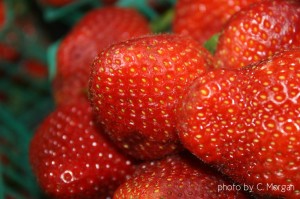
The Environmental Working Group has released its 2013 list of The Dirty Dozen Plus and The Clean Fifteen.
The suggestions given by EWG are based strictly on the levels of contamination from pesticide. The Clean 15 list does contain items that are potentially genetically modified, so you must be aware of this fact when shopping, as I recommend strict avoidance of GMOs. Field corn and nearly all papayas from Hawaii are genetically modified. Some varieties of sweet corn, tomatoes, and zucchini are also genetically modified.
By purchasing your produce locally as much as possible, you can learn more about the source of your fruits and vegetables, and whether or not they were from GMO seeds. You can find a very comprehensive directory of local farms, co-ops and CSAs across the country HERE.
The Environmental Protection Agency warns that the ingestion of pesticides can cause health problems such as “birth defects, nerve damage, cancer, and other effects that might occur over a long period of time.” Especially at risk of harm from pesticides are children.
Infants and children may be especially sensitive to health risks posed by pesticides for several reasons:
- their internal organs are still developing and maturing
- in relation to their body weight, infants and children eat and drink more than adults, possibly increasing their exposure to pesticides in food and water
- certain behaviors–such as playing on floors or lawns or putting objects in their mouths–increase a child’s exposure to pesticides used in homes and yards
Pesticides may harm a developing child by blocking the absorption of important food nutrients necessary for normal healthy growth. Another way pesticides may cause harm is if a child’s excretory system is not fully developed, the body may not fully remove pesticides. Also, there are “critical periods” in human development when exposure to a toxin can permanently alter the way an individual’s biological system operates. (source)
The website What’s On My Food takes a stronger stance than the EPA regarding the risks of pesticides.
The human health impacts linked to pesticide exposure range from birth defects and childhood brain cancer in the very young, to Parkinsons’ Disease in the elderly. In between are a variety of other cancers, developmental and neurological disorders, reproductive and hormonal system disruptions, and more.
- Autism
- Breast Cancer
- Children’s diseases
- Endosulfan
- Gestational diabetes
- Parkinson’s Disease
The Dirty Dozen this year is actually the Dirty Dozen Plus, since there were two extra items that needed to take the walk of shame. The items on this list have high pesticide loads and should be purchased organic if at all possible:
- Apples
- Celery
- Cherry Tomatoes
- Cucumbers
- Grapes
- Hot Peppers
- Nectarines (imported)
- Peaches
- Potatoes
- Spinach
- Strawberries
- Sweet Bell Peppers
- Kale/Collard Greens
- Summer Squash
On the bright side, there is another list. If you are on a budget and can’t get everything organic, these conventionally grown items are relatively safe choices:
- Asparagus
- Avocados
- Cabbage
- Cantaloupe
- Sweet Corn (not to be confused with potentially GMO canned corn)
- Eggplant
- Grapefruit
- Kiwi
- Mangoes
- Mushrooms
- Onions
- Papayas
- Pineapples
- Sweet Peas
- Sweet Potatoes
You can download The Shopper’s Guide to Pesticides in Produce™ HERE.
The EWG ranks 48 produce items from most pesticide to least pesticide HERE.


























